I guess there’s not enough real drama in the gun culture, so we have to manufacture our own for entertainment.
In the days before digital media ruled, the gun magazines (“gunzines,” or “gun rags” to us bonafide gun nuts) were alive with such weighty debates as “9 vs. 45,” “Weaver vs. isosceles,” and “Glock vs. 1911.” A lot of ink was spilled over these comparisons, just as previous generations had busily argued the merits of “Colt vs. Smith,” “revolver vs. auto,” “.270 vs. .30-06,” “lever action vs. bolt gun,” and “iron sights vs. scopes.”
We’ve made great strides in our understanding and knowledge since the early days, but we’re still prone to dabbling in animated debates about equipment choices and techniques in the digital era. A whole new generation of shooters has accepted the task of resolving such burning questions as “M-Lok vs. Keymod,” or “red dot vs. LPVO.” They have also (in a tip of the hat to their dads and granddads) relit the “9 vs. 45” torch, because . . . well, it’s just so much fun. One of my “favorite” dramas though, centers around “appendix carry vs. strong side hip.”
Danger Will Robinson!
It seems that appendix carry has become very controversial in the modern era, pitting large camps of shooters against each other in a battle that sometimes verges on the hysterical.
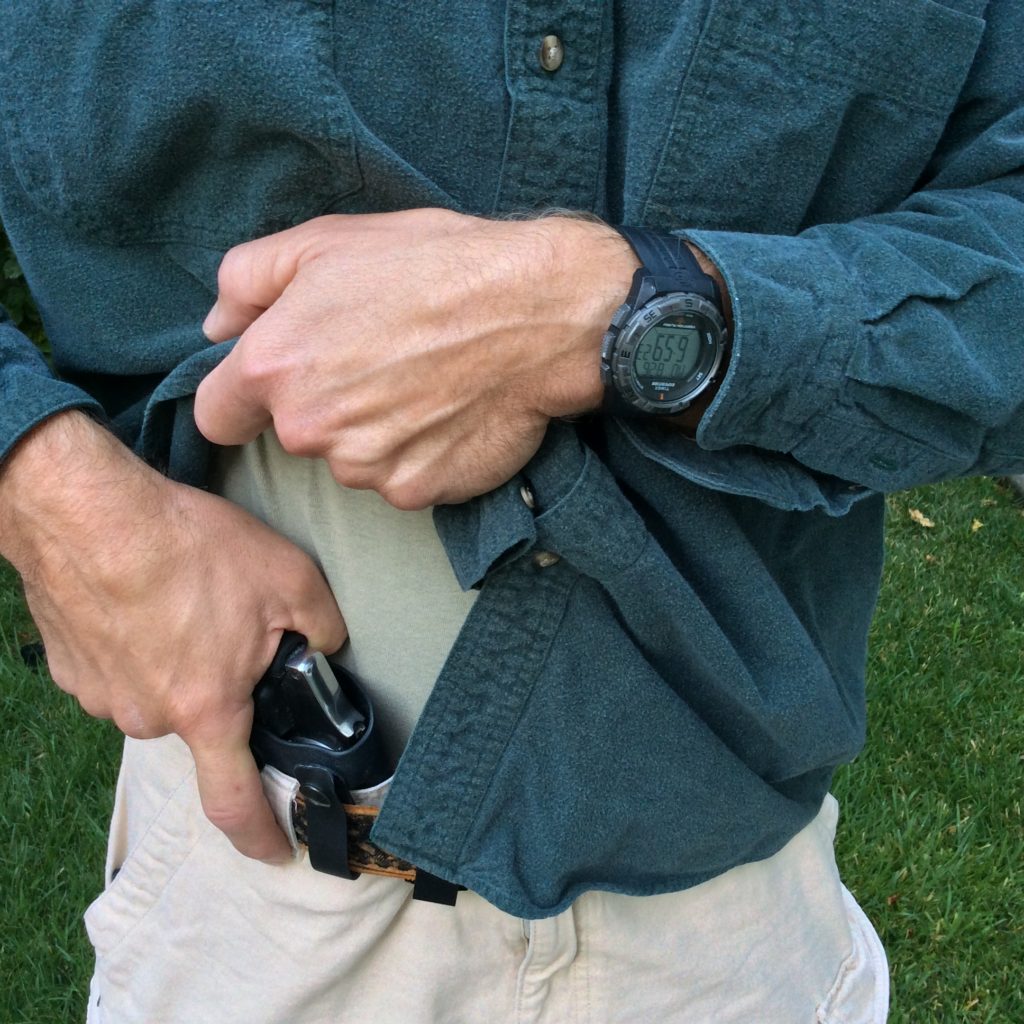
I won’t attempt to solve that dilemma in these pages, but will merely note that people with poor attention, habits, composure and training can injure or kill themselves with just about anything, so appendix holsters don’t have a unique claim on those dangers. Without slugging it out, point by point, let’s just say I think appendix carry is an excellent method to carry a gun for someone who is willing to do the work and build the necessary habits. It’s my preferred carry mode, and I think the advantages outweigh the disadvantages for my particular situation, but I respect your opinion and choice if you feel differently.
Nothing New Here
It’s interesting that some elements of the gun community dismiss appendix carry as a new and passing fad. The historical record actually shows that good guys and bad guys have been shoving handguns into the front of their waistband between 10 and 2 O’Clock since at least the percussion era (look at some old photos and see how many folks carried guns tucked into sashes and belts up front), so it’s not exactly a new carry mode.
Even so, holster manufacturers were (and still are, in some corners) hesitant to build holsters for this carry style, due to liability and safety concerns. In fact, when the resurgence of interest in appendix carry really began to build steam in the mid-to-late 1990s, there weren’t many places where you could go to purchase a dedicated appendix rig. Some leather makers had neutral cant, inside the waistband (IWB) holsters that worked nicely (such as Bruce Nelson, or Milt Sparks—who built a lot of Nelson designs), but more often than not, IWBs of the era had forward cants that made them inappropriate for use in appendix (AIWB) carry.
Fortunately for us, the industry was rapidly changing, and one of the players at the forefront of this change was Dale Fricke.
A New Direction
Fricke was a longtime shooter and firearms trainer, with a resume that included teaching for Chuck Taylor’s American Small Arms Academy, among other things. He had started a holster business with a partner in the mid-1990s that didn’t last long, due to professional differences, and shortly thereafter went into the ministry.
It didn’t take long before Fricke recognized a need for a more discrete method of carrying a pistol. His background as a trainer and his continued service as a volunteer deputy naturally influenced his desire to carry a firearm, but in his new role as a clergyman, it was even more important to keep it concealed.
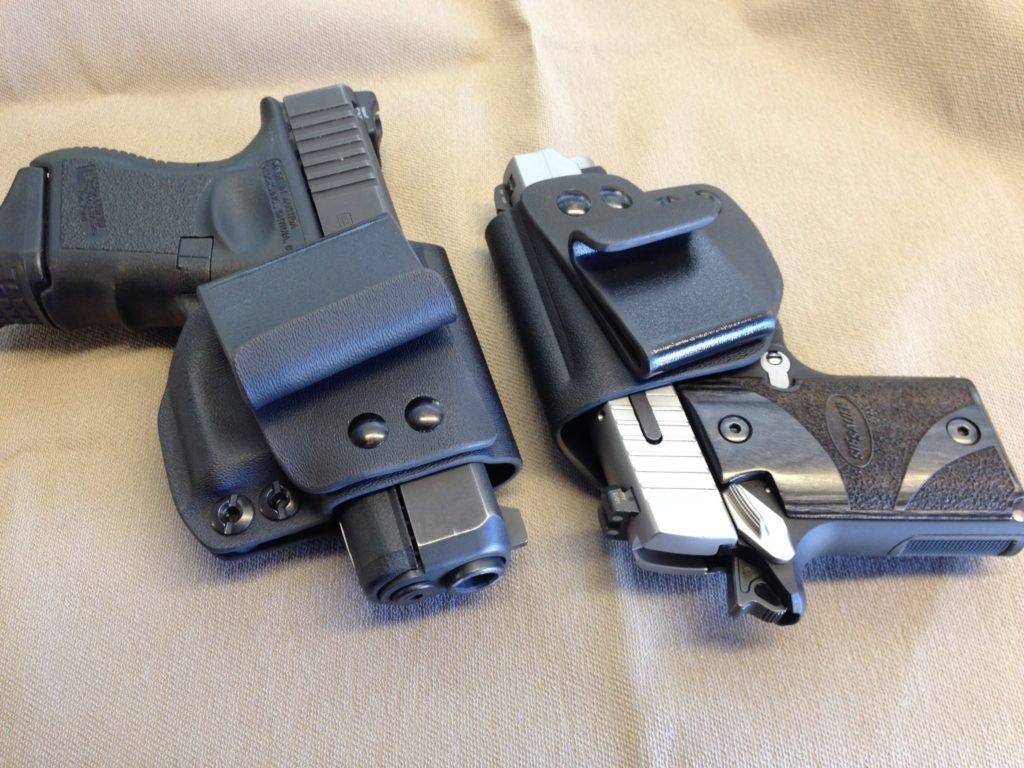
A pair of Joshua Covert holsters. Image from https://dalefrickeholsters.com
Since he couldn’t find what he needed, he decided to design his own holster. This design, which exists in the catalog today as the Joshua Covert, was a strong side, IWB holster with a unique, low-profile hook attachment. The most significant element of this holster for our purposes here though, was not the design, but the material it was made of.
Fricke fashioned the Joshua Covert out of Kydex, a sheet polymer that was impervious to solvents, sweat, and other corrosives, and which had a high degree of impact resistance. In practice, Fricke heated and formed the Kydex around the gun using tools that had been manufactured by a machinist friend, leaving him with a holster that was both rigid and durable, despite its minimalist nature.
Fricke’s holster design attracted the attention of friends and professional associates, who asked him to manufacture samples for their own use. For a while, Fricke ran what he called a “holster shop in a box,” occasionally borrowing some work space in his machinist friend’s shop to make the holsters, then packing the tools back up into a box and storing them on a shelf until the next visit. Over time though, Fricke realized there was enough demand for his product to make a go of it, and he launched Dale Fricke Holsters.
Kydex Boom
His timing was excellent. There had been a few people making Kydex holsters before Dale, such as Michael Horne (who produced a Bud Watson design known as the “Snick,” with marketing and design assistance from Michael Harries in the early-1970s), Bill Rogers (whose use of Kydex and Kydex-leather laminates changed the police duty holster market forever), Kevin McClung (who started using Kydex to manufacture sheaths for his Mad Dog Knives designs, and later shifted to holsters at the urging of the nearby Gunsite staff), and Tim Wegner (of BladeTech fame, who also started with knife sheaths before dabbling in holsters), but the Kydex holster market was still in its infancy, and there was lots of room for a maker with high quality, unique designs to set up his tent.
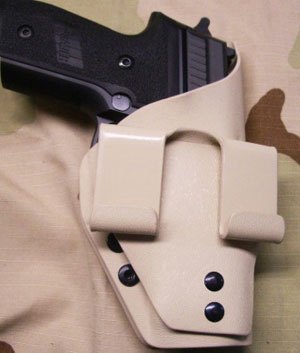 The Ehud holster. Image from https://dalefrickeholsters.com
The Ehud holster. Image from https://dalefrickeholsters.com
The resurgent interest in AIWB dovetailed nicely with the Kydex Boom, and before long, Dale had designed what was probably the first-ever Kydex AIWB holster to hit the market—the Ehud. The Ehud had an attachment which hooked the bottom edge of the belt, and while this worked OK for some users, others felt that the weight of the gun would pull the hook down out of contact with the belt, so an alternative attachment that hooked over the top edge of the belt was created, which became the basis for the Joab holster. In turn, the Joab’s top hook attachment was eventually replaced with a pair of Pull-The-Dot straps to create the Archangel holster.
Perfect Match
It was the Archangel that convinced me to fork over my money to Dale in the early 2000s, and after buying that first AIWB holster, I never looked back.
The Archangel met all my needs for a concealment holster, and I’ve purchased a trio of them over the years for various autoloaders. The one I purchased first is still the most heavily used of them all, and serves as my EDC holster. After 15-plus years of almost daily use, it’s still in outstanding condition, having suffered no splits, breakages, or failures. Even the rubber Pull-The-Dot straps have run the course with nary a fault.
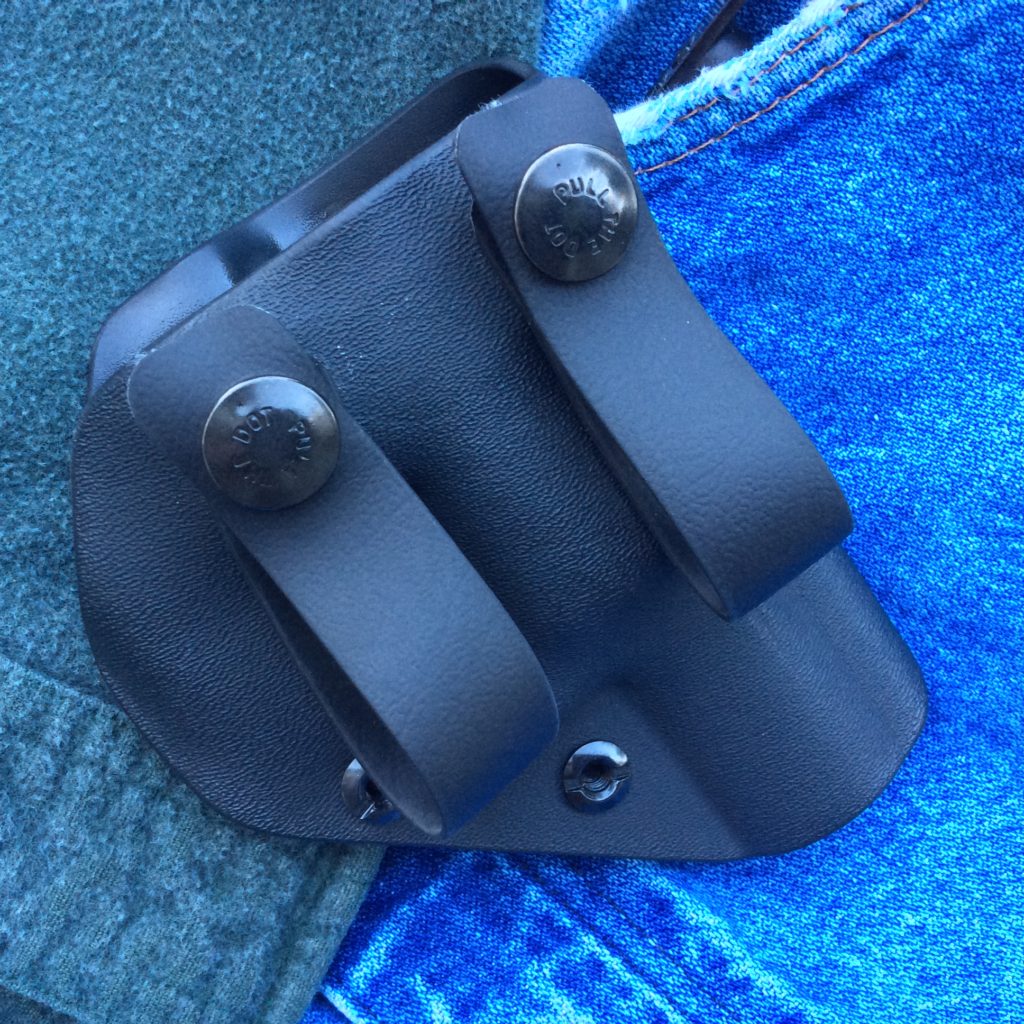 All edges on the Archangel are dehorned
All edges on the Archangel are dehorned
RevolverGuy readers will remember that I began experimenting with carrying a snub revolver in the appendix position after I received a Model 160A holster from Aker. I hadn’t previously carried a snub in this location, having reserved this carry mode for larger guns, but my work with the 160A peaked my interest in carrying a snubby up front in the AIWB position.
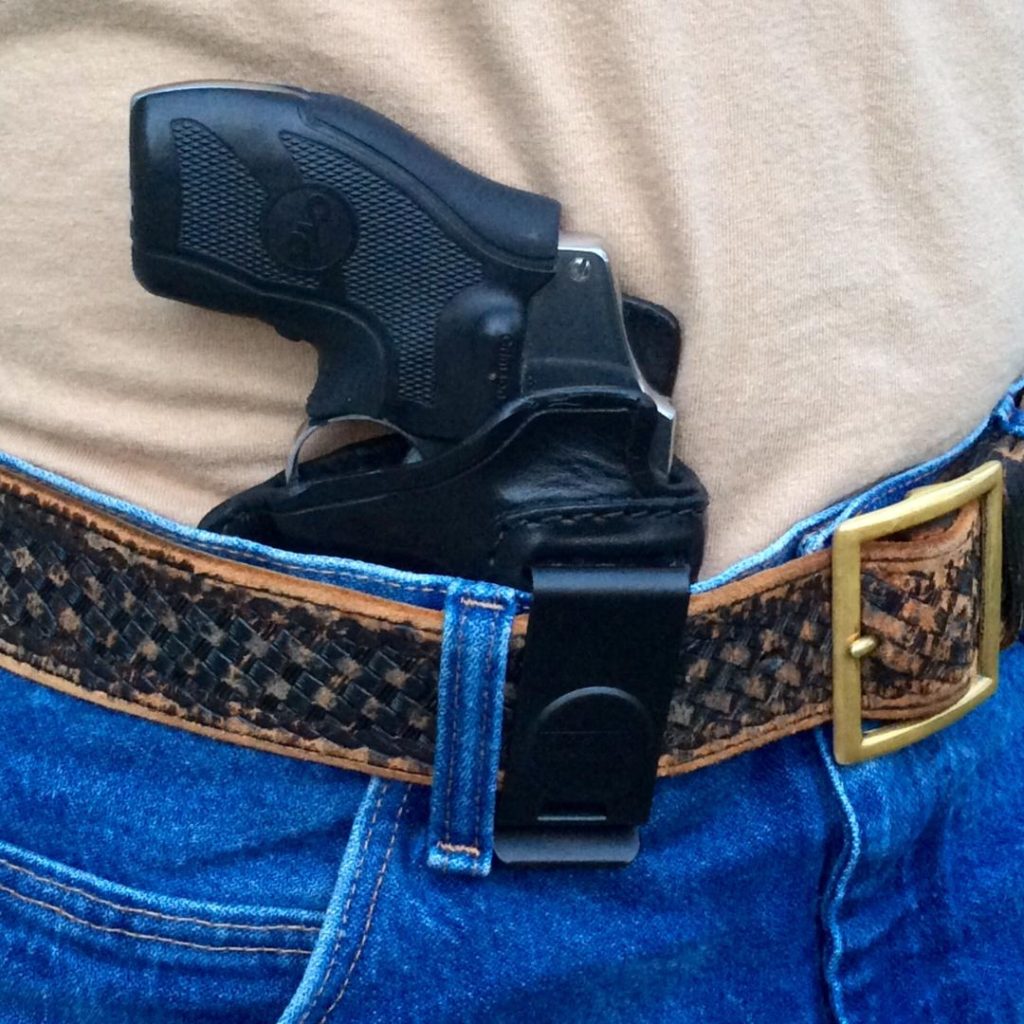 The Aker 160A has a spring steel belt clip
The Aker 160A has a spring steel belt clip
The 160A worked well enough, but I wasn’t fond of the spring steel clip attachment, and wanted a holster with a pair of straps like I had on my EDC holster. In short order, I visited Dale’s website and ordered an Archangel for my faithful S&W Model 640. The holster had been a stellar performer with my bottom feeders, so it was time to add a wheelgun version to the stable.
The Revolver Archangel
Like my other Archangels, the holster made for my snubby is made from 0.93” thick, “T”-series Kydex. Dale explains that many other makers use the thinner 0.80” and 0.60” Kydex sheets for their holsters because the material is easier to mold than the thicker 0.93” option that he prefers, and it’s also less expensive. However, Dale feels that the thicker material is the best choice for a hard-use holster, and represents the best balance between long term durability and minimizing bulk.
My previous experience proved the 0.93” Kydex is extremely robust. My old holster shows no significant wear despite near-daily use, and untold thousands of presentations in dry fire and live fire training. I’ve never felt that the thicker Kydex compromised the concealability or weight of the holster, and instead have appreciated the fact that it steadfastly retained its carefully molded shape, and never collapsed when the gun was removed. There’s a few nicks and scratches on my old holster where the edge of the front sight or extractor on my pistol has caught the material, but aside from these, the Kydex could pass for new after 15-plus years of hard use.
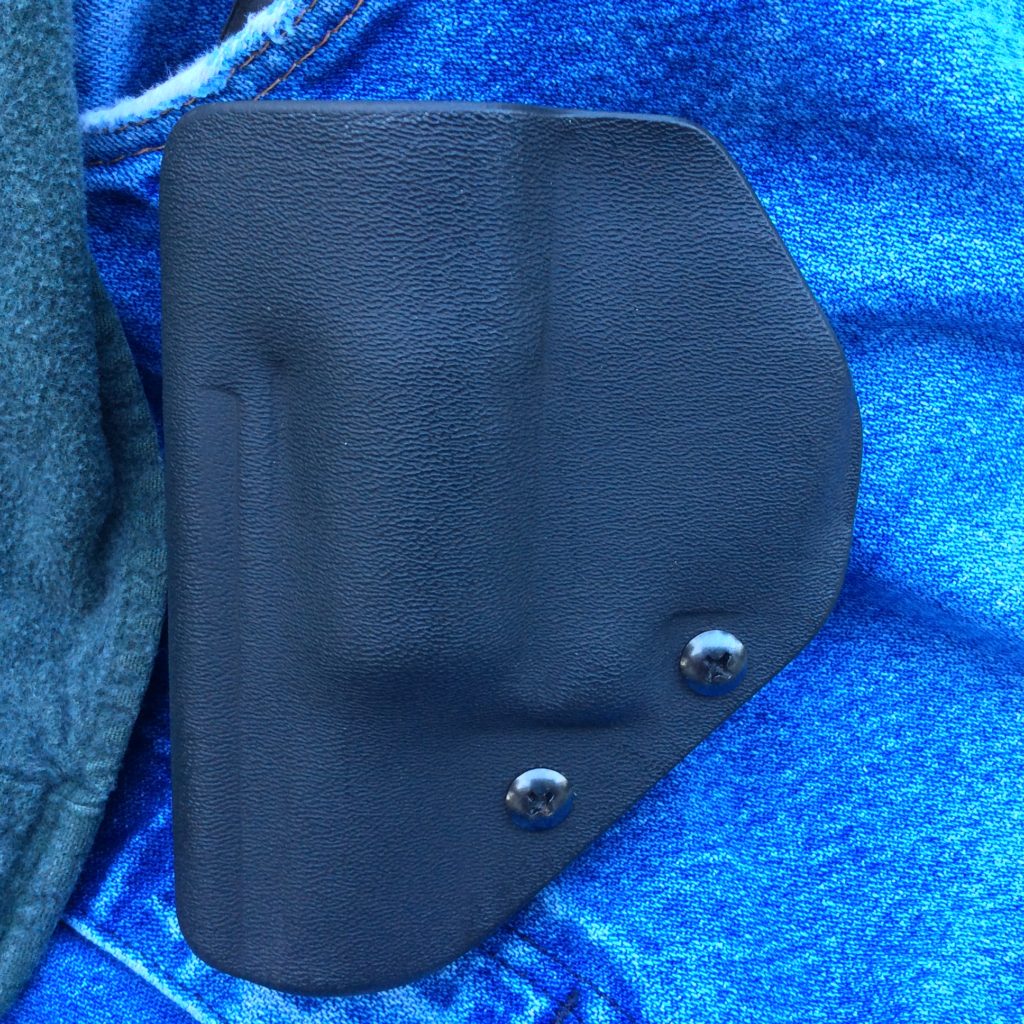
My new revolver Archangel promises to hold up the same. The squared front edge of the cylinder is probably the part that will subject the holster to the most abuse, but so far the 0.93” Kydex has shrugged it off through hundreds of draws.
One of the things that makes the Archangel so comfortable to wear is the attention that Dale pays to the edges of the Kydex. All edges are carefully rounded, or “dehorned,” to ensure there are no sharp edges to abrade the skin. I’ve seen several examples from other makers where these edges were left “square,” and I know they’d be no fun to carry.
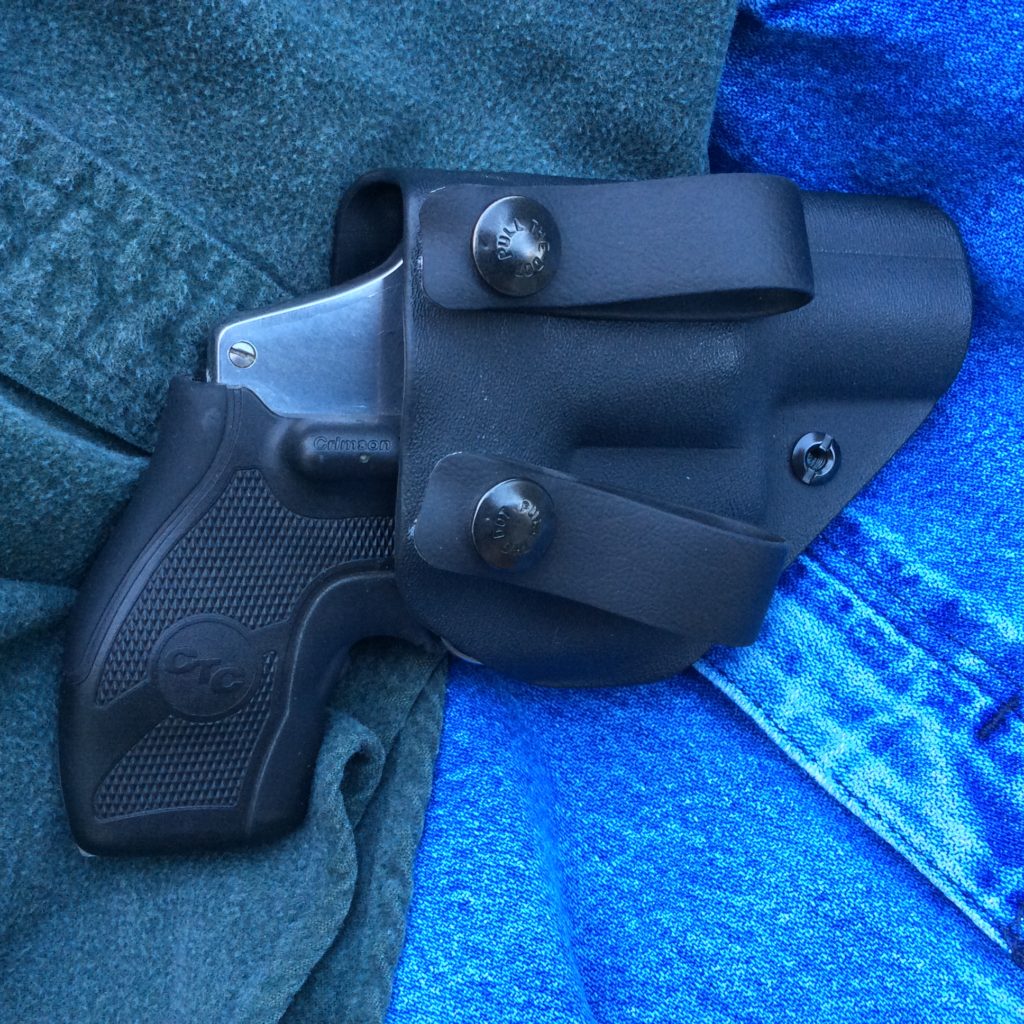
The revolver Archangel incorporates a carefully-shaped “sweat guard” on the body side of the holster, which rises only about 3/8” higher than the outside edge of the gun pocket. This isn’t much—especially compared to the larger fin on the autopistol Archangels—but it’s the perfect amount to prevent contact with the thumb piece, or cylinder release, which could make things very uncomfortable. It’s here in the sweat guard that we see clear evidence that this holster has been designed by someone who truly knows and carries guns—there’s nothing here that doesn’t need to be, no sloppy excess of material beyond that which is absolutely necessary to get the job done.
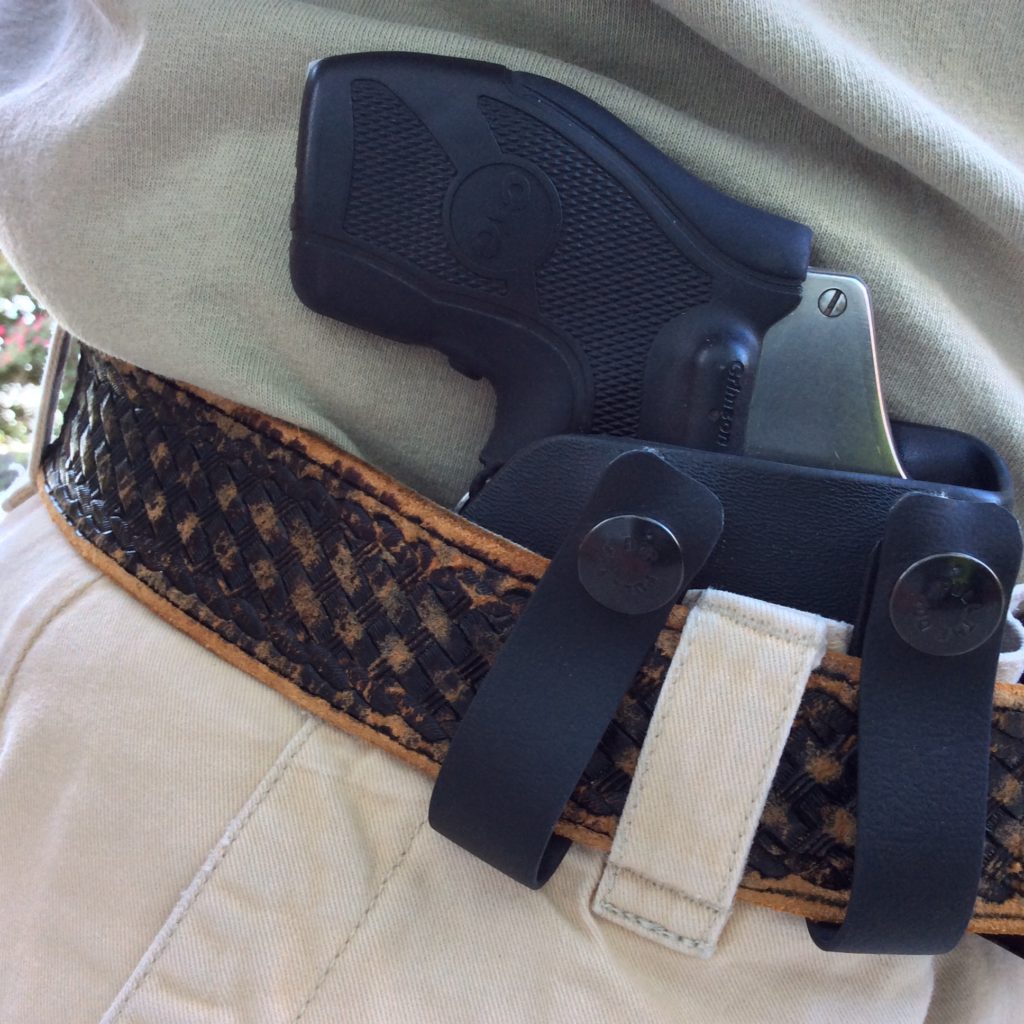
Ride height and grip clearance on the Archangel are excellent, allowing an unimpeded grasp during the draw.
The next thing a RevolverGuy will appreciate about the revolver Archangel is the ride height and grip clearance. When you put a revolver in the Archangel, and mount the holster to your belt, you’ll soon discover that the grip rides at the perfect height for easy access, without any part of the holster or belt blocking your access to it. Some holsters can be cut a little “proud” in the area around the trigger guard, but the Archangel is carefully contoured in a way that there’s zero interference as you grasp the gun, and it’s designed to ride at a height that clears the way for your fingers, so they don’t run into the top edge of the belt.
Importantly, Dale manages to accomplish this without sacrificing stability. The Archangel carries a revolver at the proper depth, with the rear edge of the cylinder at the top edge of the belt. This allows the center of gravity—focused in the cylinder—to ride low enough that the gun doesn’t want to lean outboard, and away from the body, as it might if the gun were carried higher. This tendency for a high ride gun to lever away from the body creates both concealment and comfort issues, but it’s not something you’ll have to worry about with the Archangel.
The pouch on the Archangel is minimalist in nature, with no excess of material beyond the borders of the gun. Some manufacturers of AIWB rigs leave a little too much material at the edges, which only serves to rub and bear against the body—especially the iliacus muscle that runs down the inside of your hip to the top of your thigh. This can be uncomfortable and can also cause a gun to move and print as you walk or sit.
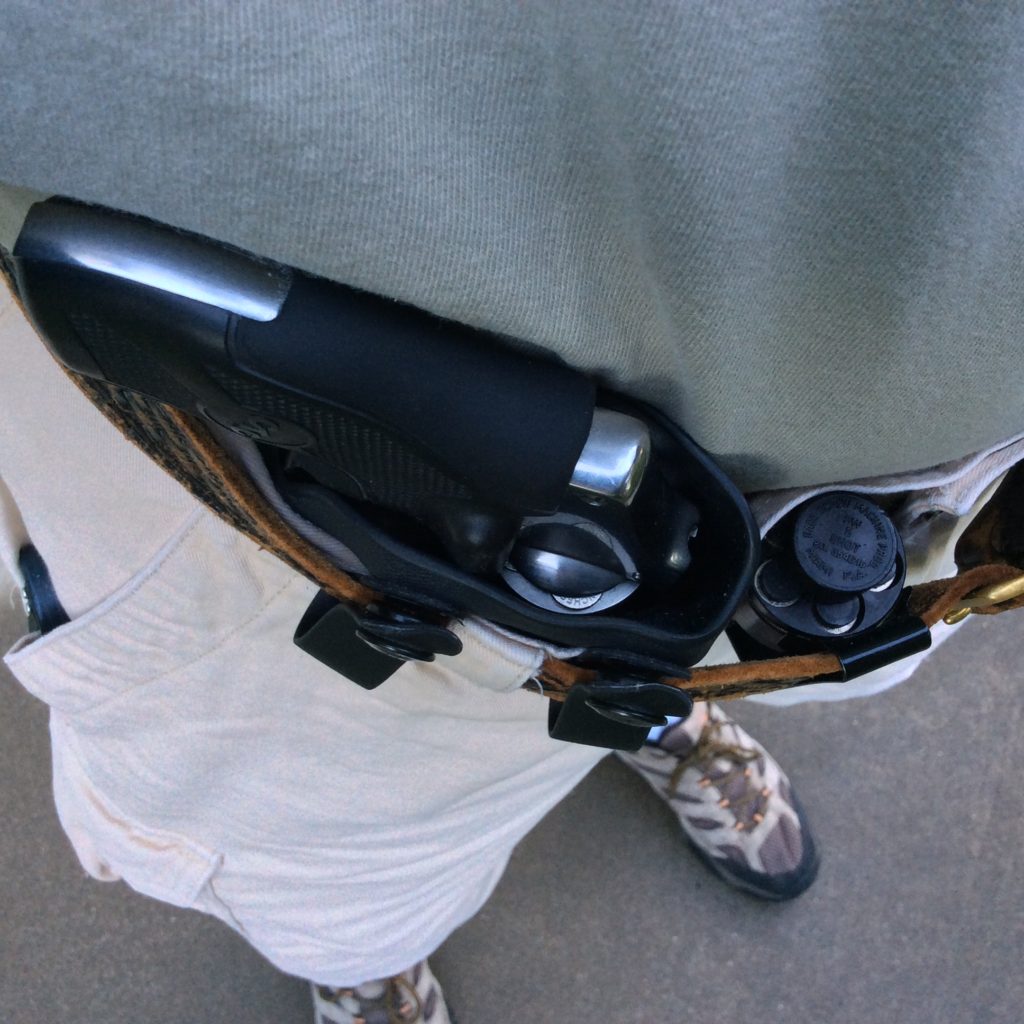
The Archangel rides nice and flat against the body. The author has been experimenting with placing a speed loader carrier in the gap that’s created between the holster body and the buckle–it’s working well, so far.
The pouch is closely molded to the gun, which gives excellent retention even without tightening the pair of retention screws on the trailing edge. Dale remarks that many of the “Blue Guns” and other inert trainers—which are used by some holster makers for molding—have tolerances that are “all over the map.” Some are good, and others are not, so it makes it difficult to use these tools and achieve a good holster fit. Therefore, Dale likes to use a real gun to shape the pouch, and the resulting fit is outstanding. The Archangel will easily pass the “upside down shake test” and keep a strong grip on the gun, even without cranking down the tension screws. Incidentally, I’ve never found a need to play with the tension screws on any of my holsters—they came well-adjusted from Dale’s workbench, and they’ve stayed put.
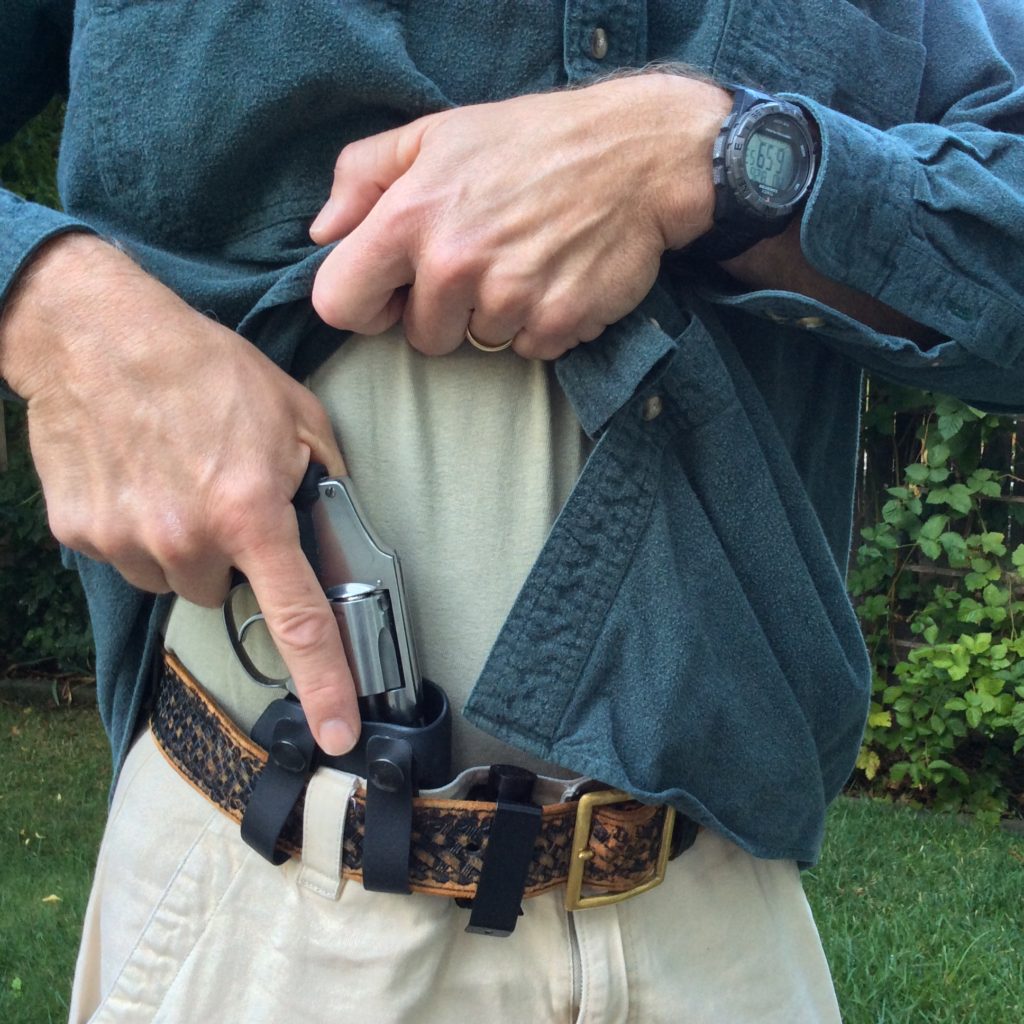
Despite the close fit of the pouch, there is an ample sight tunnel that will prevent your front blade from contacting the inside of the holster during the draw. The tunnel on my Archangel is generous, and I have no doubt that owners of guns with larger profile blades—like the S&W 640 Pro Series—will still have plenty of clearance.
The Pull-The-Dot snaps on the Archangel’s dual belt loops are a little tight at first, but quickly break in. They make it easy to don/doff the holster without unbuckling the belt, but are robust enough to keep the holster in place during aggressive activity. I really enjoy the security provided by the dual belt loops, and also appreciate the fact that they allow the holster to accommodate variations in the size and position of belt loops on different pants. A solid hook is less flexible in this regard, where a pants loop in the wrong spot can force you to carry the holster in a different location, which effects concealment, comfort, and draw efficiency. In contrast, the dual loops on the Archangel can split a pants loop effectively, and allow you to carry your holster in a consistent position.
For those who want a “tuckable” version of their holster, Dale makes the Archangel 2.0, which mounts the dual snaps to a tongue that is secured at the bottom edge of the holster. This allows the user to mount the holster to the belt via the straps, and tuck the shirt tail between the pants and the holster, to camouflage it.
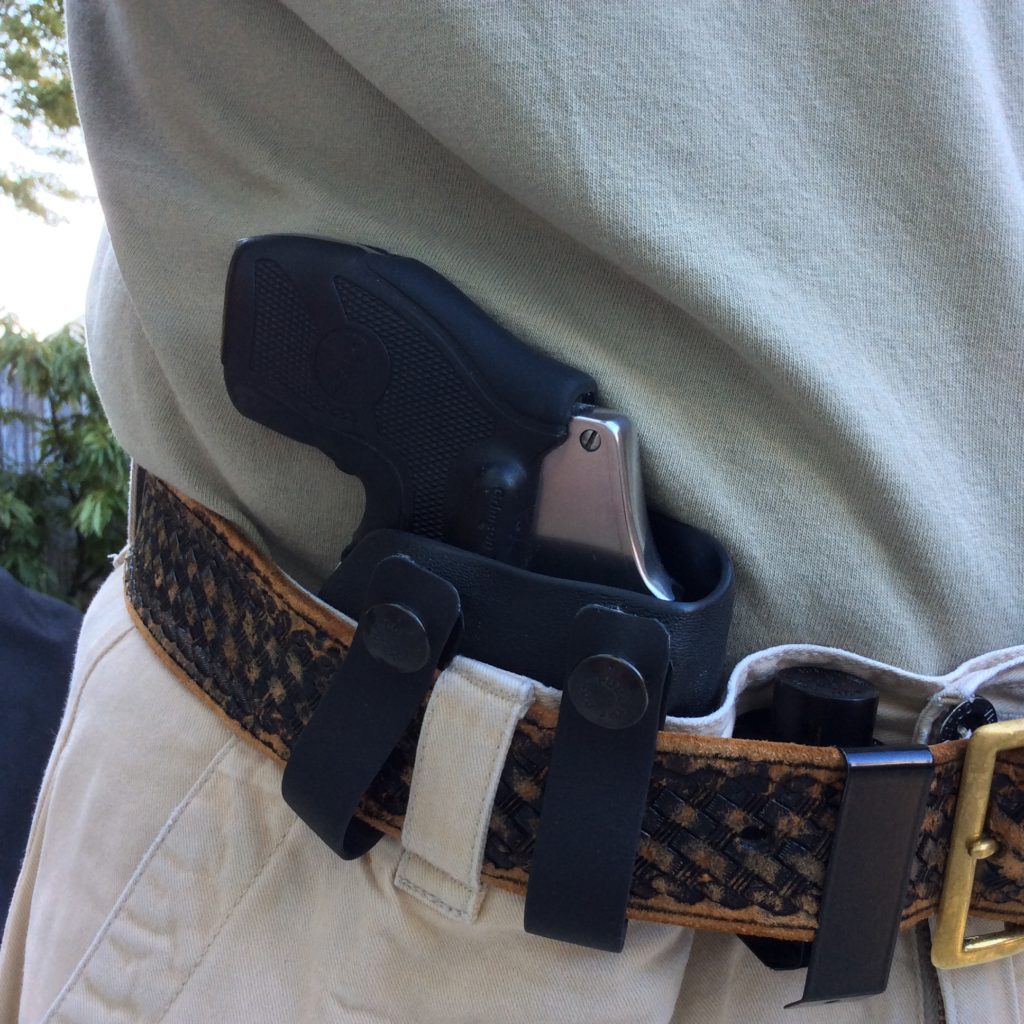
The screws that mount the dual belt loops are easily removed with a Phillips screwdriver, allowing you to change the loops to accommodate a different belt width, if desired. These screws are the only ones that I’ve ever had to tighten on an Archangel—they do back out a little over time, but it’s easy to snug them back down. RevolverGuys will certainly appreciate that the hardware on the back is recessed so that it won’t make contact with the gun and wear the finish.
Old Dogs and New Tricks
Attentive RevolverGuys know that I’m a big fan of leather holsters and belts. I have always appreciated the qualities of a good leather product, and the craftsmanship required to make it.
Despite my love for leather, I’m a solid fan of Kydex and recognize that it’s a superior product in many ways. Kydex is tough and durable, and you can get a more rigid holster for less bulk. It doesn’t soak up moisture, is easy to clean and maintain, and won’t rot away. Perhaps most importantly, it doesn’t squeak and doesn’t require a long break in period!
Kydex may not have the charm or other qualities of leather, but I’m sold on it. I’m also sold on the outstanding qualities of Dale Fricke’s Archangel AIWB holster. It may seem a little sacrilegious to the Old Guard to put a traditional weapon like a double action revolver in a holster made from modern materials, but the combination is an excellent one. RevolverGuys who are in the market for a Kydex holster—regardless of carry mode, whether it be inside the waistband, outside the waistband, or appendix—are highly encouraged to check out Dale’s website. I know you’ll be as pleased with his holsters as I am!
A Huge “Thank you” to our Patreon Supporters! If you aren’t one, think about Supporting RevolverGuy on Patreon!


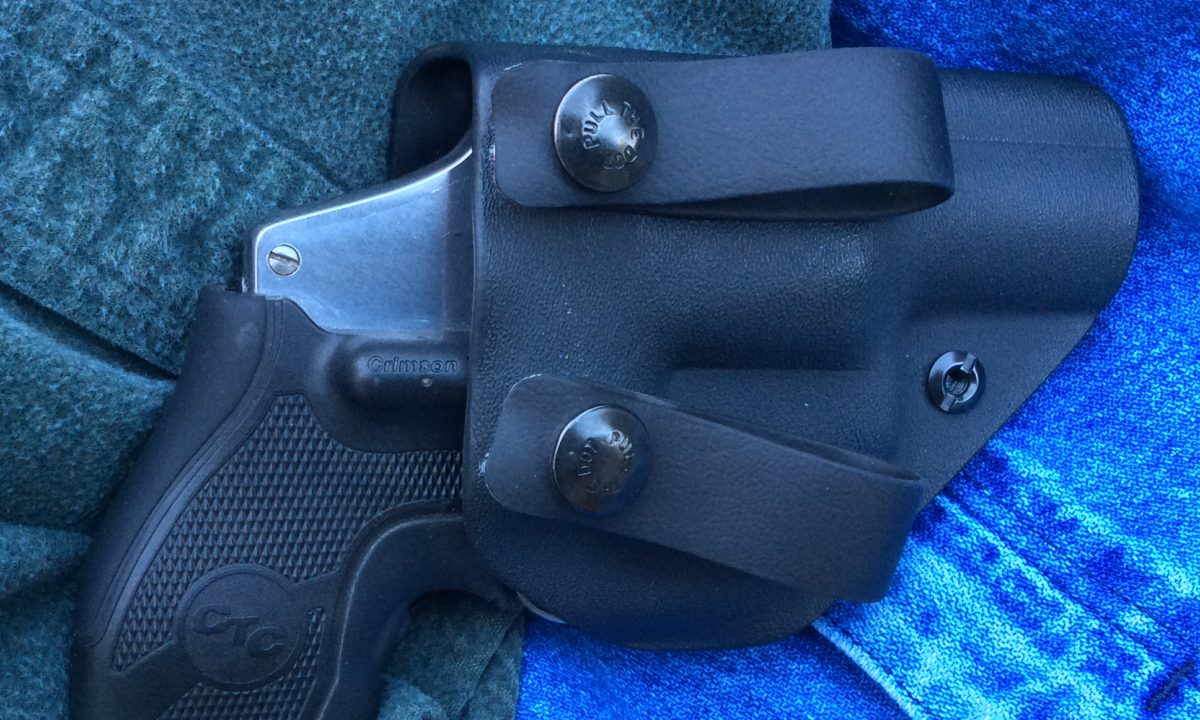
Thanks for a thorough history and review. I pocket carry my snubs, but I have no safety concerns with appendix carry, at least with a small DAO revolver. If I were to change my carrying style, these holsters look perfect.
I’m just not going to point the barrel of a gun at my junk.
I carry crossdraw because of major shoulder surgeries. Appendix carry could be beneficial but I just can’t point the barrel at my body, especially not the junk.
That being the holster appears to be well designed. Old guy my preference is still for quality leather holsters.
I certainly agree for striker-fired pistols. I would only carry one OWB, if an overwhelming need for compact polymer afflicted me.
For a modern small wheelgun, however, I do not see the danger of an AD, no matter where it gets carried. After slimming down to 80% the man I used to be, other forms of carry are now possible, but the right pocket holster and belt, coupled with lots of practice, work best for me.
Appendix carry works until you get older and develop Dunlop’s Disease . . . then things get problematic.
I’m not trying to be a dick, but I think this is important to address: if you’re carrying a gun to prolong your life, you should also take care of your body to prolong your life. This isn’t necessarily directed at the original poster; if the shoe fits…
Being overweight, and especially carrying an excess of adipose tissue around the midsection is linked to all manner of threats that a gun won’t help you with. This increases your risk of type II diabetes, heart disease, stroke, some forms of cancer. All of these will kill you just as dead as a guy with a gun or knife. It can interfere with your sleep (which impacts nearly everything) and put strain on your back…and dictate where you carry your carry gun.
You’re much more likely to need to save your own life – and massively improve its quality in the process – by losing excess weight than you are by using a gun. To ignore one’s own health but carry a gun is similar to carrying an extra head gasket in your car, but neglecting to keep air in the tires. Yeah, you *might* need both, but you’re much more likely to be taken off the road by one than the other.
Again, not trying to be rude or on a high horse. I genuinely care about the readers here and would be remiss if I didn’t call things like I see them. As my buddies Rich Brown and Mike Seeklander frequently say on the American Warrior Show: the best accessory you can get for your gun is a gym membership!
How true about taking care of the body as a self defense stratagem.
How true about physical fitness being a vital part of a “self defense” strategy. That applies in numerous ways, all valid. When I’m in a weight regimen and lifting moderate weights but lots of reps, my revolver scores jump up 15-25 points on a 300 possible course of practical shooting.
Found that to be so over the past 30 years.
I guess if we create our drama, the good news is there’s not much real drama to be a problem… That said, I sat through a movie with my daughter last night wearing my Glock 43 appendix, and boy did that hurt! Therefore strong side OWB is better, so there! ?
A G43 at appendix hurt? What holster were you using?
For those who don’t like Appendix Carry, Dale has a full line of OWB and traditional IWB holsters that are definitely worth checking out. He’s a master of his craft, and will build you a great holster for whatever your preferred belt-carry mode is. Don’t let my focus on a single Appendix design from his catalog steer you away from him.